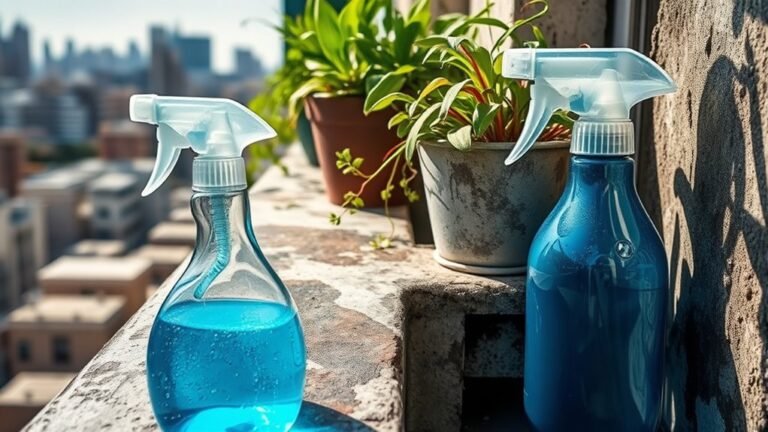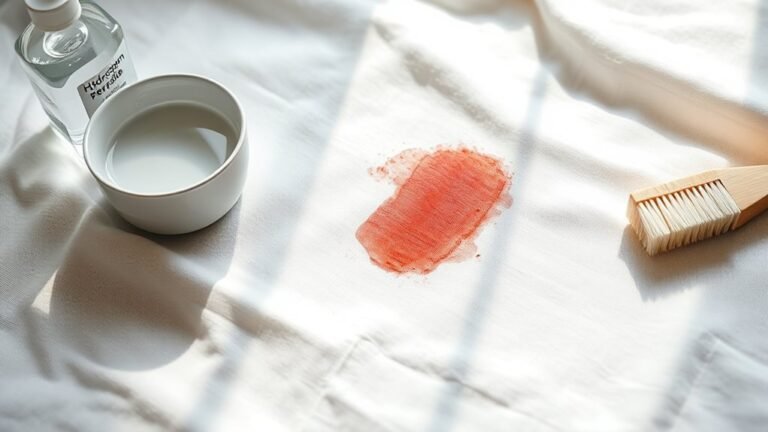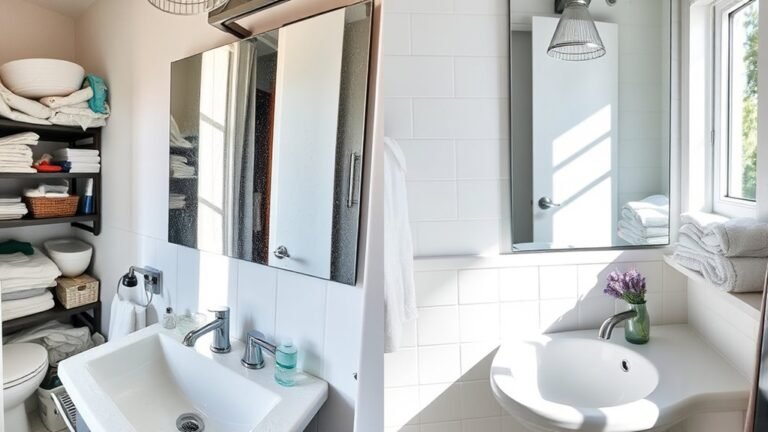Step-By-Step Guide to Cleaning Mattress
Start by removing all bedding and vacuuming your mattress thoroughly using a hose attachment to eliminate dust and debris. Spot clean stains gently with a mild detergent or vinegar solution, testing first on a hidden area. Next, deodorize by sprinkling baking soda evenly and letting it sit for a few hours before vacuuming. Air out your mattress in a well-ventilated spot, ideally in sunlight. Finish by protecting it with a cover and following a regular cleaning routine. For more detailed tips, keep exploring these care steps.
Gather Necessary Cleaning Supplies
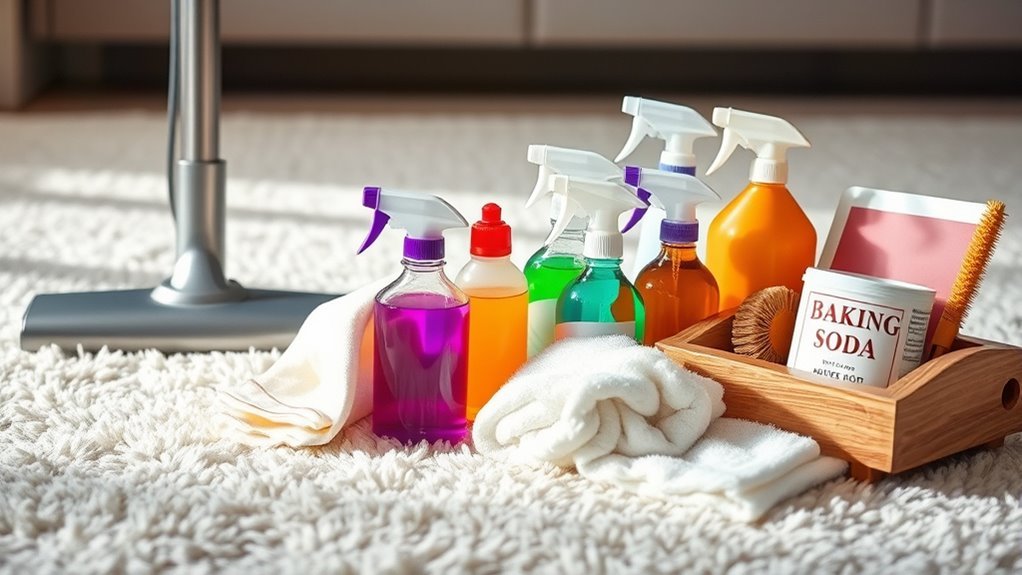
Before you begin cleaning your mattress, it’s important to gather all the necessary supplies. Having the right cleaning supplies on hand guarantees you work efficiently and effectively. Essential items include a vacuum cleaner with a hose attachment, baking soda for deodorizing, and a spray bottle filled with a mixture of water and mild detergent or white vinegar. You’ll also need clean cloths or microfiber towels for blotting stains, and a soft-bristled brush to gently agitate any dirt. Optional but helpful are enzyme cleaners for stubborn stains, and protective gloves. By assembling these essential items before you start, you set yourself up for a straightforward, thorough cleaning process that lets you reclaim your mattress’s freshness without hassle.
Remove Bedding and Vacuum the Mattress
Start by stripping all bedding from your mattress, including sheets, pillowcases, and mattress protectors. This clears the surface and allows you to fully access the mattress for vacuuming. Vacuum your mattress thoroughly using a handheld or upholstery vacuum to remove dust, allergens, and debris. Follow mattress maintenance tips by vacuuming regularly—ideally once a month as part of cleaning frequency recommendations.
| Action | Purpose |
|---|---|
| Remove all bedding | Access mattress surface |
| Vacuum mattress | Eliminate dust and allergens |
| Follow schedule | Maintain mattress freshness |
Spot Clean Stains Using Appropriate Solutions
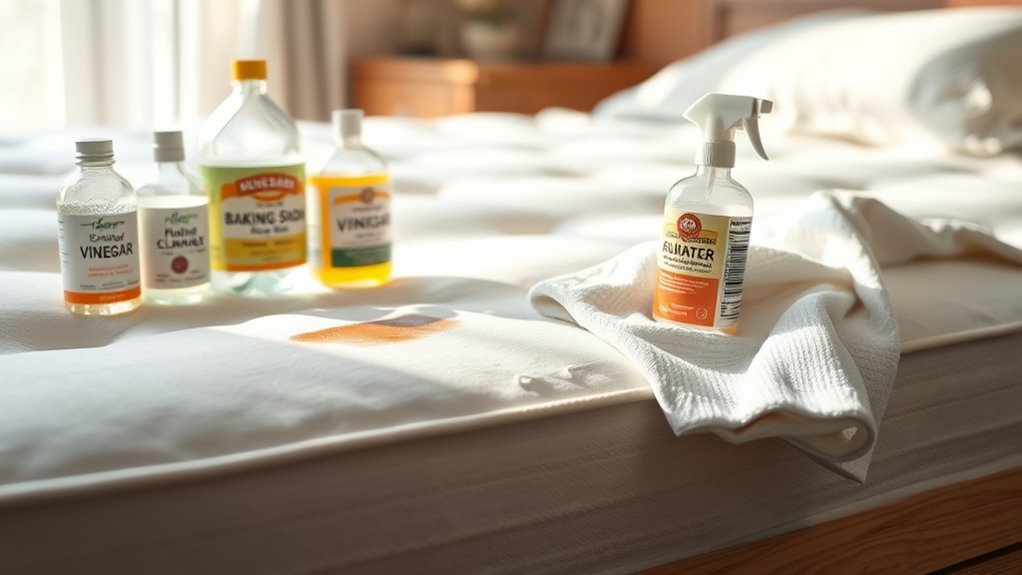
Once you’ve vacuumed the mattress to remove dust and allergens, you can focus on tackling any visible stains. Start by identifying the stain type to select the right cleaning solution. For protein-based stains like sweat or blood, use a mixture of cold water and mild detergent. For grease or oil stains, apply a small amount of dish soap diluted in water. Always test the cleaning solution on a hidden area first to avoid damage. Dab the stain gently with a clean cloth soaked in the solution—never rub, as it can spread the stain. After spot cleaning, blot the area with a dry cloth to absorb excess moisture. Effective stain removal requires patience and precision, but with appropriate cleaning solutions, you’ll restore your mattress’s cleanliness without hassle.
Deodorize the Mattress With Baking Soda
To deodorize your mattress effectively, sprinkle a generous layer of baking soda evenly across the surface. Let it sit for several hours to absorb odors before vacuuming it off completely. This simple method neutralizes smells and freshens your mattress without harsh chemicals.
Benefits of Baking Soda
A key benefit of using baking soda on your mattress is its ability to effectively neutralize odors. Baking soda acts as a natural deodorizer, absorbing moisture and unpleasant smells without harsh chemicals. This means you can refresh your mattress safely and maintain a cleaner sleeping environment. It’s gentle yet powerful, making it ideal for those sensitive to synthetic fragrances or allergens. Additionally, baking soda’s affordability and availability make it a practical choice for regular mattress care. By incorporating baking soda into your cleaning routine, you enhance comfort and extend the mattress’s lifespan. This simple step supports your freedom to sleep fresh and clean, free from unwanted odors. Embracing baking soda guarantees your mattress stays inviting, promoting restful and healthy sleep every night.
Application Techniques
Sprinkle baking soda evenly across the mattress surface to start deodorizing effectively. Use a fine mesh sieve or shaker to distribute the powder uniformly, ensuring every inch is covered. For enhanced stain removal, combine baking soda with your preferred cleaning solutions, applying this mixture directly to spots before sprinkling more baking soda on top. This method not only neutralizes odors but also helps break down stains. Avoid saturating the mattress; baking soda works best dry. After application, let the baking soda sit undisturbed to absorb moisture and odors naturally. This step is essential for freeing your mattress from unwanted smells without harsh chemicals. Following these application techniques gives you control over stain removal, letting you maintain a fresh mattress and enjoy the freedom of a clean sleeping space.
Duration and Removal
Although the baking soda needs sufficient time to absorb odors and moisture, you shouldn’t leave it on the mattress for more than 24 hours. Duration estimates typically range from 30 minutes to a full day, depending on odor intensity. For light deodorizing, 30-60 minutes may suffice, while stronger smells require several hours. When it’s time to remove the baking soda, use strong removal techniques like vacuuming thoroughly with a vacuum cleaner’s upholstery attachment. Avoid brushing, as this can grind the powder deeper into the fabric. Make sure you cover the entire treated area, repeating vacuum passes for complete extraction. Following these duration estimates and removal techniques guarantees your mattress stays fresh without residue, giving you the freedom to enjoy a clean, odor-free sleeping surface effortlessly.
Air Out the Mattress to Eliminate Moisture
You should air out your mattress regularly to remove trapped moisture, which helps prevent mold and odors. The best time to do this is on dry, sunny days when ventilation is ideal. Simple techniques like standing the mattress upright or placing it near an open window can speed up the drying process.
Benefits of Airing Mattress
When you air out your mattress, you help eliminate trapped moisture that can lead to mold, mildew, and unpleasant odors. This simple step plays an important role in maintaining mattress freshness, creating a healthier sleep environment. By reducing moisture, you prevent allergens and bacteria from thriving, which directly contributes to improved sleep quality. A well-aired mattress also feels less damp and more comfortable, supporting your body better throughout the night. Regular airing extends your mattress’s lifespan by reducing wear caused by excess humidity. Taking this action empowers you to control your sleep space, promoting freedom from discomfort and health issues related to damp bedding. Ultimately, airing your mattress is a practical, effective way to enhance both hygiene and restful sleep.
Best Airing Times
Choosing the right time to air out your mattress can greatly improve moisture elimination. For ideal airing, aim to expose your mattress during the warmest, sunniest part of the day—typically between 10 a.m. and 3 p.m. This timing strategy leverages natural heat and sunlight to accelerate moisture evaporation efficiently. Avoid airing your mattress when humidity is high, such as early mornings or evenings, as this can hinder drying. On dry, breezy days, open windows or use a fan to enhance airflow further. Consistency is key; regular airing sessions scheduled during these ideal times will maintain a fresh, dry mattress and extend its lifespan. By mastering these timing strategies, you gain control over moisture elimination and create a healthier sleep environment with minimal effort.
Techniques for Moisture Removal
Several effective techniques can help you air out your mattress to eliminate moisture efficiently. Proper moisture absorption and drying techniques not only prevent mold but also keep your mattress fresh. Start by placing your mattress near a window or in a well-ventilated room. Use fans to increase air circulation. Sunlight helps evaporate moisture naturally but avoid prolonged exposure to prevent fabric damage. You can also use baking soda to absorb residual dampness before vacuuming it off.
| Technique | Benefit |
|---|---|
| Open windows | Promotes fresh air flow |
| Use fans | Accelerates drying process |
| Sunlight exposure | Natural moisture evaporation |
| Baking soda | Absorbs lingering moisture |
| Mattress flipping | Exposes all sides to air |
These drying techniques guarantee your mattress stays dry and odor-free.
Protect the Mattress With a Cover or Protector
Although regular cleaning helps maintain your mattress, using a cover or protector provides an essential extra layer of defense against spills, dust, and allergens. Understanding mattress cover benefits helps you choose the right protector type for your needs. Covers protect against stains, extend mattress life, and reduce allergen buildup. You’ll find several protector types available:
- Waterproof covers guard against liquids and stains.
- Hypoallergenic protectors reduce dust mites and allergens.
- Breathable covers enhance airflow for comfort.
- Zippered encasements fully seal the mattress.
- Fitted sheet-style protectors offer easy installation.
Selecting the right protector not only preserves your mattress but also promotes a healthier sleeping environment. By investing in mattress protection, you secure your mattress’s longevity and enjoy greater freedom from frequent deep cleanings or replacements.
Establish a Regular Mattress Cleaning Routine
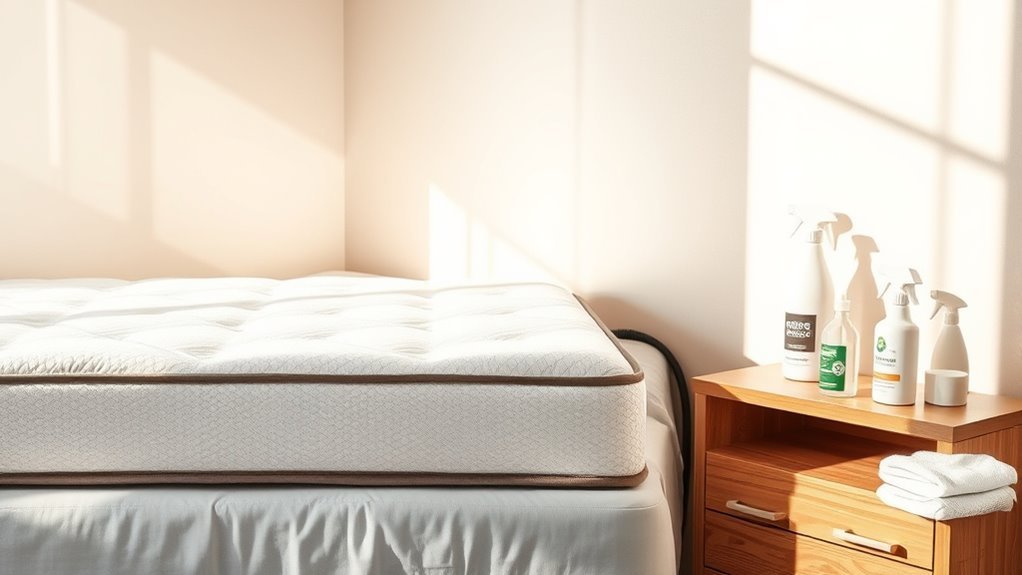
Since mattresses accumulate dust, sweat, and allergens over time, establishing a regular cleaning routine is vital to maintain hygiene and extend their lifespan. You should aim to clean your mattress at least twice a year, but increasing cleaning frequency can benefit those with allergies or pets. Begin with vacuuming every one to two weeks to remove dust and debris. Spot clean stains promptly using mild detergent and water to avoid buildup. Rotate your mattress every three months to guarantee even wear. Incorporate mattress care habits like airing it out regularly to prevent moisture and odors. Sticking to this routine minimizes allergens and prolongs comfort, giving you freedom from frequent replacements or health issues. Consistency in mattress care is key to preserving your sleep environment.
Frequently Asked Questions
How Often Should I Replace My Mattress Entirely?
Think of your mattress like a trusty typewriter—solid but eventually outdated. Typically, a mattress lifespan is around 7-10 years. You’ll want to replace it sooner if you notice signs replacement is needed: sagging, lumps, or waking up sore. Allergies or poor sleep quality also signal time for a new one. Staying proactive guarantees you’re free from discomfort, letting you rest easy and wake refreshed every day.
Can Mattress Cleaning Help Reduce Allergies?
Absolutely, regular mattress cleaning plays a key role in allergy reduction by removing dust mites, allergens, and bacteria that build up over time. When you commit to proper mattress maintenance, you create a healthier sleeping environment that can ease allergy symptoms and improve your overall well-being. Keeping your mattress clean isn’t just about hygiene—it’s about reclaiming control over your sleep quality and living allergy-free.
Are There Any Health Risks With DIY Mattress Cleaning?
Imagine sailing your freedom ship through stormy seas; DIY mattress cleaning can feel just like that. Without proper care, certain cleaning methods might expose you to health hazards like respiratory issues from harsh chemicals or mold spores stirred up. To avoid these risks, choose gentle, natural cleaners and guarantee thorough drying. By taking careful steps, you protect your health while keeping your mattress fresh—maintaining both freedom and well-being.
What Is the Best Mattress Type for Easy Cleaning?
If you want a mattress that’s easy to clean, memory foam with hypoallergenic materials is your best bet. Memory foam resists dust mites and allergens, so you won’t have to deep clean as often. Plus, hypoallergenic fabrics reduce irritants, making maintenance simpler. You can easily spot clean and air it out without worrying about damage. Choosing these materials gives you freedom from constant scrubbing while keeping your sleeping space healthy.
Can Professional Mattress Cleaning Remove Bed Bugs?
Imagine your mattress as a fortress under siege by bed bugs. Professional services act like skilled knights, using heat treatments and specialized chemicals to wipe out these pests effectively. While they can’t guarantee total bed bug prevention alone, their expertise is your best defense. Combining their help with regular cleaning and protective covers grants you the freedom to sleep peacefully, knowing your mattress is safe and bug-free.

